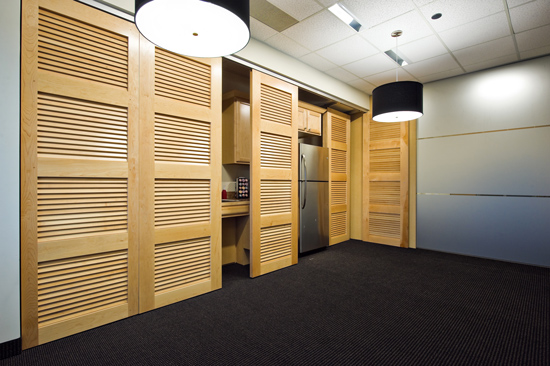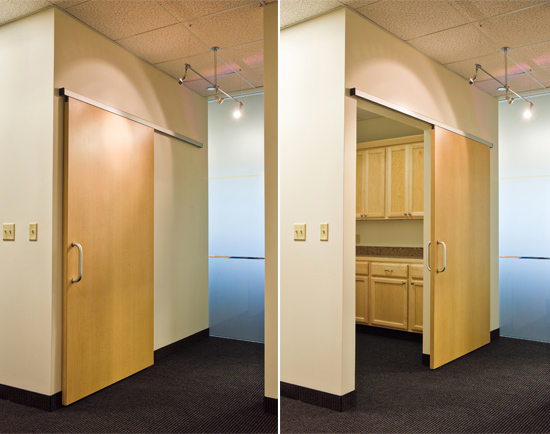Innovate with Sliding Door and Wall Systems
Specifying Sliding Door and Wall Systems
The best place to begin when looking to incorporate sliding door or wall systems into a space is with a good specification. Here are some tips for specifying a sliding hardware system that will meet project needs and work smoothly and reliably for many, many years.

The most critical aspect of a sliding hardware system to identify during specification is the weight of the panels that will be used.
Specifying Single-Panel Straight Doors
The most critical aspect of any sliding hardware system, from a single-panel door to the most elaborate stacking wall, to identify during specification is the weight of the panels that will be used. Every sliding system is rated to be able to manage a specific amount of panel weight. Selecting the right system for a project depends upon selecting a system that can support the exact type of door that is going to be used. Exceeding the weight capacity for which the system is rated can result in damage to the trolley, the track, or the suspension, impeding performance, and may even cause system failure.
In order to determine the exact measurements and weight of the door panel that will be used in a single-panel door application, it is important to start by identifying the size of the opening, in both height and width, and selecting the panel material, usually glass, wood, or metal.
Now it is time to determine the necessary width of the door panel. One significant difference between selecting a pivot door and a sliding door is the need to consider overlaps. While pivot doors are designed to fit snugly into the opening, sliding doors need to overlap the opening to prevent sightlines into the space when the door is closed and, in some cases, to conceal the door guide. To determine the size and number of the necessary overlaps, the decision must be made on how the door is going to be applied in the space. Designers will need to decide whether the door is going to reside in a pocket and be pulled flush to the edge of the wall when closed, requiring that the door be wide enough to provide overlap on only one side of the opening, the side with the recessed pocket, or if the door is going to slide along the outside of the wall, in a barn door style application, in which case the door will need to provide overlap on both sides of the opening. The width of a single-panel door is determined by the opening width plus the amount of overlap necessary. A typical 36-inch-wide opening may require a sliding door that is 40 inches wide.

Sliding doors that slide along an opening in a barn door style need to be wide enough to overlap both sides of the opening to eliminate sightlines into the space when the door is in place.
Once the size of the door is determined, designers can find out how much a panel of that size weighs in the desired panel material. A sliding hardware system with an appropriate capacity can then be selected, and designers can choose from available track mount and suspension mounting options. As a rule of thumb, designers specify the track length as two times the width of the door panel.
Specifying a Telescoping Door
When specifying a telescoping system, where the panels extend and retract from one side, the same emphasis is placed on identifying the weight of the panels in order to select an appropriate sliding hardware system. It is important to remember that in a telescoping system, the panels must provide an overlap at each of the panels, as well as an overlap with the two sides of the opening. A 6-foot opening that will be covered with two telescoping doors will not use two 3-foot doors, instead it may require two doors that are each 40 inches wide.
Specifying a Folding Wall
There are two types of folding systems: a center-hung folding system and an edge-hung folding system. When specifying a folding system, the first decision to make is which of these two systems is the best fit. In a center-hung panel system, the trolley is mounted mid-panel. This creates a very stable panel system that will not shift or sway significantly as it opens and closes. For this reason, it may not require a guide, meaning that there is no need for a continuous floor-mounted guide channel throughout the space. In an edge-hung folding system, the trolleys are mounted at the edge of the panel. Because of gravity, the panels that are edge-hung will want to twist as they open and close, so edge-hung systems do require a guide and a small guide channel in the floor that will be visible even when the system is parked against the wall.
In terms of aesthetics, edge-hung panels offer better symmetry because all of the panels are the same size. This is not the case with center-hung folding systems because the first panel must be narrower than the rest of the panels.
Depending upon the application, the clearance area for the wall when it’s parked may or may not be an issue. When center-hung folding systems stack, the panels are centered on the track, with half of the panel width extending either side of it. When edge-hung folding systems stack, the entire panel extends to one side of the track. If the panel system is being used to divide one large space into two smaller spaces, the clearance of the stacked panels probably doesn’t matter. In scenarios where these panel systems are used to define a boundary, like a mall store front, the difference in clearances becomes a much more important feature because half of the parked center-hung panel system will hang out into the hallway or common area.
Once the decision has been made between a center-hung and edge-hung folding system, the specific panels and hardware are ready to be specified. The folding system is specified in bi-fold sets, meaning that each specified hardware set is for a pair of panels that will fold onto each other. The set adjacent to the wall is the first, basic set. Continue adding pairs of panels and the associated hardware until the necessary wall length has been reached to fill in the opening. Then the pivot doors can be added either onto the folded stack or on the opposite side adjacent to the wall. Next select the top track, guides, bottom guide channel, if required, and the hinges.
Specifying a Stacking Wall
Stacking systems provide unparalleled variability in the types of configurations into which it can be designed. These panels can move back and forth independently, and the track can incorporate curves and corners. When specifying a stacking system, the best place to start is to determine where the wall is needed, map out the configuration of the track, and identify the total size of the opening. Pivot doors can also be included in the stacking wall, providing points of egress where desired or required by code.

Stacking systems provide unique storefront solutions for malls, airports, and hotel lobbies.
Another important decision is to determine how the panels should be parked and whether or not they will be visible or hidden when not in use. Panels can be parked parallel or perpendicular to the track, depending upon space constraints of the application. If the parking area will be exposed, there are ways to make the parking area track more aesthetically pleasing. The interior section of the track can be concealed so that the back of the track and the trolleys are not visible.
The wasted space required by hinges and swinging doors is an unnecessary opportunity cost in today’s built environment, as is the rigidity delivered by permanent wall structures in many interior spaces. Consider specifying a sliding door or wall system into any project where space efficiency and flexibility are primary design objectives. The opportunity for significant returns in square footage and value-driven space use is, literally, at the door.

|
Hawa Americas Inc. |








